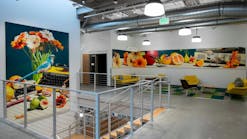Norwegian hospital bidding farewell to hazardous fluorescent tubes
With Europe’s fluorescent lighting phase-out now in full force, a Norwegian hospital has turned to Oslo-based supplier Glamox AS for a variety of LED luminaires to replace some 34,000 tubes over the next several years.
University Hospital of North Norway in Tromsø is working through GK, an Oslo-based electrical and HVAC contractor.
GK is installing a mix of Glamox downlights and linear luminaires across the hospital including in patient wards, recovery rooms, operating rooms, staff rooms, offices, technical rooms, toilets, and nurses’ accommodations.
Glamox does not supply LED tubes. Rather, it sells “integrated luminaires,” which are fixtures with LED chips mounted on a circuit board.
In some areas of the hospital, GK is reusing existing fluorescent housings by also including Glamox LED retrofit kits, which include an LED driver along with the integrated LED light source. GK is also adding new Glamox optics at the hospital (the Glamox kits are available with or without fresh optics). In other areas, GK is installing completely new luminaires.
Glamox has explained in the past that a straight-up swap of LED tubes for fluorescent T5 and T8 tubes compromises LED output and lifetime, and also invalidates manufacturers’ CE markings (roughly the equivalent of UL in the U.S.). Installers would have to re-validate the CE.
In a Glamox website video, Glamox product manager Knut Marius Fosse further explained that LED tubes in fluorescent housings provide only about 15% energy savings over the fluorescents, while a completely new luminaire delivers around 85% savings. The LED kit approach provides somewhere in the middle, at about 40% to 50% energy savings, he said. Retrofit kits also help prevent material waste because they continue to use existing housings, similar to remanufacturing methods. They also spare redecorating and rebuilding costs and processes. CE responsibility remains with the manufacturer.
One potential drawback of LED kits is that they can add to preparation time, because kits are tailored made for each different housing. Hospital settings tend to have uniform fluorescent housings, which can mimimize this inconvenience, Fosse noted, adding that once kit preparation is complete, installation time is short. Another drawback, compared to installing a whole new luminaire, is that lifetime can be shorter because heat management is not optimized for the LED setup.
Glamox said it expects lighting-related electricity savings of up to 69% at the hospital.
Installation started in September. The hospital’s contract with GK runs through July 2025, with a possible two-year extension after that. The parties did not reveal pricing.
Glamox expects Europe’s fluorescent phase-out to help drive sales for its Professional Building Solutions division, which remains the largest of its two business units, although the Marine, Offshore & Wind operation is growing at a faster pace.
“There are at least 10 million fluorescent tubes in Norway alone, all of which will need replacing over time,” said Glamox CEO Astrid Simonsen Joos.
The E.U. has, in stages, prohibited the manufacturing of different categories of fluorescent lighting because it contains mercury, a harmful substance. In August, a ban on standard-life T5 and T8 tubes took hold, following a February halt to long-life versions of the same. Various home bulbs have also been outlawed. All the actions came under the E.U.’s RoHS (Restriction of Hazardous Substances) directive.
MARK HALPER is a contributing editor for LEDs Magazine, and an energy, technology, and business journalist ([email protected]).
Follow our LinkedIn page for our latest news updates, contributed articles, and commentary, and our Facebook page for events announcements and more. You can also find us on the X platform.
Mark Halper | Contributing Editor, LEDs Magazine, and Business/Energy/Technology Journalist
Mark Halper is a freelance business, technology, and science journalist who covers everything from media moguls to subatomic particles. Halper has written from locations around the world for TIME Magazine, Fortune, Forbes, the New York Times, the Financial Times, the Guardian, CBS, Wired, and many others. A US citizen living in Britain, he cut his journalism teeth cutting and pasting copy for an English-language daily newspaper in Mexico City. Halper has a BA in history from Cornell University.






